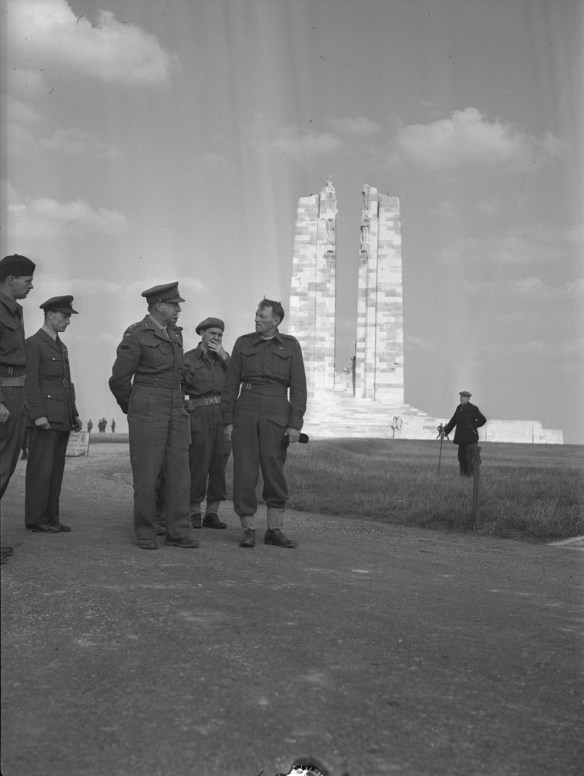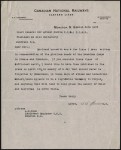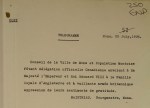By Andrew Horrall
Canadian Army Newsreel No. 42 must have been very exciting to watch in September 1944. In an era before television, cinema audiences followed the events of the Second World War through these short films.
Scenes of liberated cities in this newsreel indicated that the war in Europe had entered its final phase. A particularly poignant segment showed Lieutenant-General Harry Crerar, commander of the Canadian Army, visiting the Canadian National Vimy Memorial, which commemorates the Battle of Vimy Ridge in the First World War.

Lieutenant-General Harry Crerar’s plane approaching the Vimy Memorial, September 11, 1944 (e011166203)
The Vimy Memorial, which was unveiled in 1936 before thousands of Canadian veterans and their families, dominates the battlefield and is the most moving shrine to Canada’s wartime sacrifices. Photographs of Adolf Hitler visiting the memorial soon after it was captured by the Germans in 1940 were the last images that Canadians had seen of it, and many believed it had been destroyed. When Canadian war correspondent Ross Munro visited the newly liberated memorial on September 1, 1944, he marveled that it “seemed almost as if it had been swept and polished for this visit, but it had been like this through four years of war. It made you intensely proud to see it standing there, a symbol of the gallantry and sacrifice of the last war and which might well become the same for this war.”

Lieutenant-General Harry Crerar and Paul Piroson (left) at Vimy Ridge, September 11, 1944 (e011166202)
Newsreel images of General Crerar’s entourage walking across well-tended grounds to the memorial, which gleamed in the late-summer sun, confirmed Munro’s description. The group was followed by a man in a tweed jacket and beret who was eventually seen speaking with Crerar as the narrator proclaimed, “Even during the occupation, the caretaker kept the Vimy Memorial grounds in order.”
The man in the newsreel was Paul Piroson. Still photographs taken during the visit also show Crerar talking to George Stubbs, who seems too old for his private’s uniform. The two men told Crerar about how they and their wives had safeguarded the memorial during the German occupation.

Lieutenant-General Harry Crerar talks to George Stubbs, with Paul Piroson in the distance, Vimy Ridge, September 11, 1944 (e011166202)
George Stubbs was an English-born butcher who joined the Canadian Expeditionary Force in Winnipeg in 1914. He fought at Vimy Ridge, married a woman named Blanche in 1919 and settled in England.
Like many veterans, Stubbs had been deeply moved by the war. He returned to Vimy in the early 1920s, paying tribute to those with whom he had served by helping the Canadian government to preserve the battlefield. Piroson, who had grown up nearby, was hired at about the same time.
Stubbs became a familiar figure at Vimy, helping to build the memorial and explaining the valour and sacrifice of Canadians to thousands of visitors each year. When the memorial was unveiled, he became its official caretaker.
George and Blanche Stubbs decided to remain at Vimy with their four children when the Second World War started in 1939. The Allies still controlled France the following spring, when George sent $25 to the Canadian Legion, expressing a desire to help “those of my comrades who are not so fortunately placed as myself.” The words seem ironic today, because the Germans overran France within weeks, sending the Stubbs family racing to the port of Bordeaux in hopes of escape. They were too late and went into hiding, but were arrested in October 1940.
George Stubbs spent the rest of the occupation in an internment camp near Paris, while Blanche and the children returned to the family cottage at Vimy, where they reunited with Paul Piroson and his wife Alice.
The trio of adults ensured that the memorial was treated respectfully while in enemy hands, by explaining to German soldiers about its significance and also preventing damage from vandals. While they were outwardly courteous and deferential, Paul hid weapons for the Resistance in the tunnels under the battlefield.
When George Stubbs was liberated in August 1944, the Canadian Army provided him with the uniform he wore to meet Crerar. Though Stubbs was a civilian, these were likely his first new clothes in years. George then joined Blanche and the Pirosons at Vimy, where they greeted Allied soldiers, told their stories to reporters, and hired local workers to clean and repair the site.

Simone Stubbs, daughter of George and Blanche Stubbs, on the Vimy Memorial, ca. 1944–1948 (e010786286-v8)
George and Blanche Stubbs stayed at Vimy until 1948, when they returned to Canada. After experiencing two world wars, it is not surprising that George proclaimed he would never go back to Europe.
Paul Piroson succeeded George Stubbs as the Vimy Memorial’s caretaker, protector and guide. The Pirosons were devoted to Canada, a country they had never visited at the time. The couple named their cottage “The Maple Leaf” and always wore the symbol on their jackets. Though only Paul was paid, the pair both led tours and enforced a strict, old-fashioned reverence for the site—women were not permitted to wear shorts, children had to be well behaved, and food was forbidden. Each year on Remembrance Day, Paul laid a wreath for the Canadian government.
When Paul retired in 1965, veterans convinced Prime Minister Lester B. Pearson to invite the Pirosons to Canada as official guests for the 50th anniversary of the Battle of Vimy Ridge. Though Pearson’s invitation dates from a time when women’s work was regularly overlooked, he thanked the pair equally for their “close personal association with so many Canadian service personnel during both world wars, your great kindness to so many of them and your hospitality and help to Canadians who have returned to Vimy Ridge.”
The Pirosons took part in Vimy commemorations across Canada in 1967. When a reporter asked about their impressions of the country they had represented for so long, Alice replied, “We both think a lot of Canadians.” Her simple words expressed the deep gratitude for Canadian wartime sacrifices that had inspired the devotion of the Stubbs and Piroson families to the Vimy Memorial.
Visit the Flickr album for images of Canadian National Vimy Memorial.
Andrew Horrall is an archivist at Library and Archives Canada.














